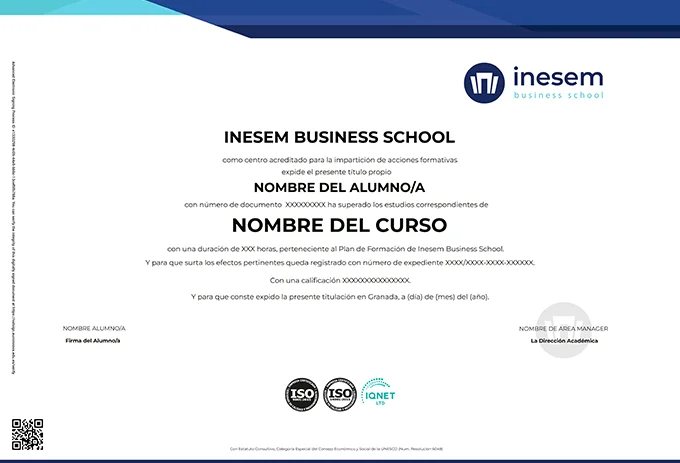- Presentación
- Temario
- Metodología
- Titulación
Descripción
¿A quién va dirigido?
Objetivos
Salidas Profesionales
Temario
UNIT 1. INTRODUCTION TO THE NETWORK
- Main elements of a network
- Network technology
- Support for business continuity
UNIT 2. PROTOCOL STANDARDISATION
- OSI Model
- Pragmatic Approach of the Layer Model
- Standards and Organisations
UNIT 3. DATA TRANSMISSION AT THE PHYSICAL LAYER
- Role of a network interface
- Options and Configuration Settings
- Booting from the Network
- Data encoding
- Signal conversion
- Transmission Supports
UNIT 4. COMMUNICATIONS SOFTWARE
- Network card configuration
- Network card driver installation and configuration
- Protocol stack
- Detecting a network problem
UNIT 5. NETWORK AND INTERCONNECTION ARCHITECTURE
- Topologies
- Choosing the adapted network topology
- Communications Management
- Interconnection
UNIT 6. THE LOWER LAYERS OF PERSONAL AND LOCAL NETWORKS
- Lower Layers and IEEE
- Ethernet and IEEE 802.3
- Token Ring and IEEE 802.5
- Wi-Fi and IEEE 802.11
- Bluetooth and IEEE 802.15
- Other technologies
UNIT 7. MAN AND WAN NETWORKS: PROTOCOLS
- Local network interconnection
- Remote access and virtual private networks
UNIT 8. PROTOCOLS FOR MIDDLE AND UPPER LAYERS
- Main protocol families
- IP protocol version 4
- IP protocol version 6
- Other Internet layer protocols
- Voice over IP (VoIP)
- TCP and UDP transport protocols
- TCP/IP application layer
UNIT 9. PROTECTING A NETWORK
- Understanding the need for security
- Tools and Types of Attack
- Protection Concepts in Local Area Network
- Network Interconnection Protection
UNIT 10. NETWORK REPAIR
- Introduction to network repair
- Diagnosis in lower layers
- Using Adapted TCP/IP Tools
- Analysis Tools for Upper Layers
UNIT 11. SAFE COMMUNICATIONS: LAYERED SECURITY
- Security at the Physical Layer
- Security at the Data Link Layer
- Security at the Network Layer
- Security at the Transport Layer
- Security at the Application Layer
UNIT 12. APPLICATION OF A PUBLIC KEY INFRASTRUCTURE (PKI)
- Identification of the PKI Components and its Relationship Models
- Certificate Authority and its Elements
- Certificate Revocation List (CRL)
- How certificate signing requests (CSRs) work
- Private Management Infrastructures (PMIs)
- Attribute Certificate Fields
- Applications that rely on the existence of a PKI
UNIT 13. INTRUSION DETECTION SYSTEMS AND INTRUSION PREVENTION SYSTEMS (IDS/IPS)
- General Concepts
- Identification and Characterisation of the System Operating Data
- Most common IDS architectures
- Relation between the Different IDS/IPS
- Security Criteria to Establish the Location of the IDS/IPS
UNIT 14. IMPLEMENTATION AND PRODUCTION OF IDS/IPS
- Prior Analysis
- Definition of Policies to Cut Off Intrusion Attempts
- Analysis of the events recorded by the IDS/IPS
- List of Audit Records
- Establishment of the Required Levels
UNIT 15. INTRODUCTION TO THE SIEM SYSTEMS
- What Is SIEM?
- Evolution of the SIEM Systems
- Architecture of a SIEM system
UNIT 16. SIEM SYSTEMS CAPABILITIES
- Problems to solve
- Log management
- IT Compliance Standards
- Event Correlation
- SIEM solutions on the market
Metodología
EDUCA LXP se basa en 6 pilares
Titulación

INESEM Business School se ocupa también de la gestión de la Apostilla de la Haya, previa demanda del estudiante. Este sello garantiza la autenticidad de la firma del título en los 113 países suscritos al Convenio de la Haya sin necesidad de otra autenticación. El coste de esta gestión es de 65 euros. Si deseas más información contacta con nosotros en el 958 050 205 y resolveremos todas tus dudas.
Explora nuestras Áreas Formativas
Construye tu carrera profesional
Descubre nuestro amplio Catálogo Formativo, incluye programas de Cursos Superior, Expertos, Master Profesionales y Master Universitarios en las diferentes Áreas Formativas para impulsar tu carrera profesional.
Course in Computer Networks: Architecture, Protocols, and Cybersecurity
